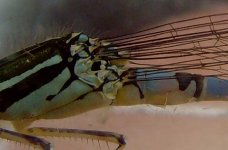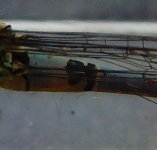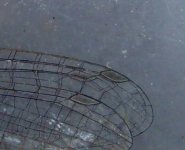A few points on the identification, variability and habits based on observations of two males today and analysis of photos
I've added some comments in reply, based on observations of a few hundred elsewhere in Europe...
Both were located low in grass within several metres of the water's edge and were clearly "small" damsels; both had the upper thorax a pale greenish - presumably this will darken to blue; the lemon yellow underside was prominent on both and included the underside of the eyes.
In an open habitat, as described, I would expect most damselflies to stay very low in vegetation, particularly if there was
any wind. In size, they average smaller than Azure Damselfly, but this is not always noticeable (and similarly small sized Azures are not infrequent. The upper thorax on the male you described will become blue, as will the underside of the eyes. I believe that the underside of the abdomen does usually (always?) remain yellowish, but this will not always be visible, and fully mature males in particular often look entirely blue and black.
Both had a prominent "Coenagrion spur" on the thorax but on neither did this form an "exclamation mark"; last year's write-ups seemed to suggest that this was a good feature but today's observations suggested otherwise (note that they did show an "incipient exclamation mark", with a slight narrowing of the coenagrion spur before a terminal blob
The "exclamation shaped" 'coenagrion spur'
might suggest Dainty Damselfly
if it is present, but it does not need to be present - the "spur" on many Dainties is similar to that on other
coenagrions.
Of great interest was the variation in the marking on S2; the first male had an E.cyathigerum type "mushroom" albeit with a very subtle dimple at the top (like last year's males); the second male had a classic thick wine goblet shaped mark.
S2 markings are quite variable in most species!
All of the other segments were patterned as expected with S6-S7 entirely black (would have extensive blue bases in puella), blue S8 and with a black "bow tie" on S9.
S6 quite often has some blue at the base (though this doesn't seem common, and if present seems to be only a small amount); Azures typically have S7 all black, and the blue base on S6 is sometimes very restricted. The black markings on S9 are very variable in both species and are of no real use at all for ID.
The Pterostigma was a fair feature but hard to assess in the field.
The length of the pterostigma may be useful in the hand, or from photographs, but the colour is of less use (initially pale in all Azures, sometimes appearing dark on Dainties!). A damselfly that appears fully mature and has a pale pterostigma is worth a close look though.
In these very open marshes the wind was a real problem and it would be clearly best to visit on a still, warm day (but how many more of those are we likely to get!). A likely peak might be mid June so should be plenty of time to catch up with them, even if they are relatively scarce.
I agree with this - there should be time to try if the weather holds out!
Here you go.... these crops summarise Alan's appraisal
Was a shot taken of the pronotum? (Which is a far more important character than those shown)
I suspect the trapping was the issue - I and all others present at the time of capture were supportive of this however and given the difficulties and variation (e.g. in the "Coenagrion spur", s2) it was IMO appropriate to catch it and photograph it.
I would hope that trapping and release is
not seen as an "issue". As Alan has indicated, it can help to aid identification, especially of individuals that do not show 'typical' markings - and if done carefully it does no harm. Damselflies are also unlikely to leave the area on release (which could be an issue if larger dragonflies are caught for examination).
Trampling of the habitat is potentially a greater issue if a site is visited by quite a few observers - keeping a short distance back from the waters edge should help to avoid this if it is thought to be a problem.






